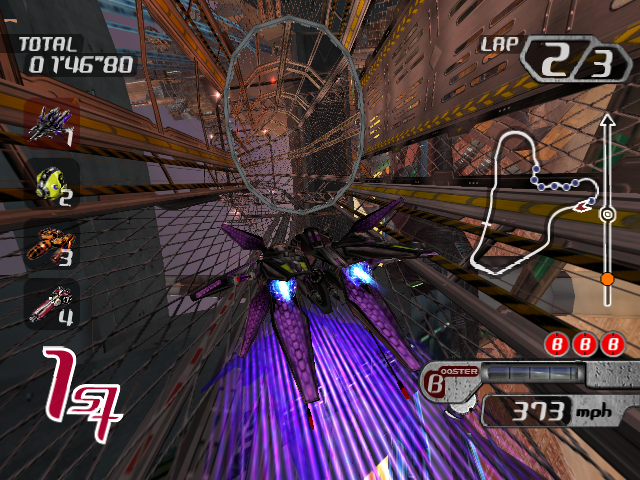
NEC came back to the US gaming scene initially with the weird Dreamcast game Industrial Spy: Operation Espionage in 2000, ending a 7-year publishing hiatus. While they had disappeared after the failure of the Turbo Grafx-16 in Japan they were a prolific publisher, supporting nearly every console overseas. With their resurgence it was thought that maybe some of their more popular franchises would come to the US, such as Black Matrix but instead we were gifted with Tube Slider, an interesting futuristic racer with interesting ideas that suffers in execution.
The similarities to F-Zero and Wipeout are there and can’t be denied. Like both games Tube Slider takes place at an indeterminate point in the future. All 3 games put behind the wheel of a hovercraft in a mad bid to finish first. But Tube Slider differs in that all races take place in tube shaped courses that allow you to drive on all sides any time you want. While F-Zero X flirted with this mechanic Tube Slider is completed based around it, for better or worse.
The tubular design is not the only unique aspect of Tube Slider however. Prior to every race you have the option to choose between Turbo and Boost, different speed increases that have their benefits. Turbo is a continuous boost that offers less speed but lasts as long as the meter lasts. The other benefit is that it can be activated after a short charge time. Boost is an instant shot of nitro that is faster but has its limitations. You can only hold 3 charges at once and each needs to be filled before activation.
While it’s obvious that everyone will have their favorites it does pay to learn the ins and outs of each course and pick accordingly. Longer straight tracks will favor boosting while the curvier tracks turbo clearer takes the lead. The shorter bursts of speed are more favorable since you won’t get the full benefit of boost. The most important mechanic of the game that is crucial to success is the ability to tailgate opponents and steal their boost, significantly increasing your own at their expense. Mastering this mechanic can quickly change your fortunes if applied correctly, but the same can also apply to you.
That mastery will take far longer than necessary however as Tube Slider has one of the steepest learning curves of any racing games I’ve experienced. The initial circuit is exceedingly easy, to the point you won’t need to bother with almost any of the game’s features. Once the second class of tracks opens up the game becomes so hard you’ll wonder if you were ever playing the game “right” to begin with. Computer racers are viciously aggressive and it seems they are always faster than you no matter what. No matter how perfectly you manage to steal boost from the computer and manage it they will always be on your tail. The rubber band AI is bad; not Mario Kart 64 level but still noticeable.
While the Tube tracks make for some interesting track design they do present problems of their own. It’s exhilarating to cruise the walls to blow past the AI opponents the sudden turns and changes in elevation have a habit of completely turning you around or worse causing a near dead stop, at which point a last place finish is assured. There are a number of track elements that don’t make sense such as rows of arrows on the walls and ceilings that give the impression of a speed boost a la most racing games. Rather these indicate the best routes but in most cases the tracks will suddenly change and make you spin out and lose speed.
Speaking of speed, there is very little sense of it. In F-Zero it’s immediately palpable when you’re approaching max speed. Outside of boosting the regular pace of the game feels agonizingly slow. It picks up slightly as you unlock more cars but it never approaches anything resembling fast. Racing games live or die by their speed; it is a race after all and unfortunately Tube Slider has a tendency to feel like an evening stroll.
Graphically Tube Slider is uneven. The game runs at a smooth 60 fps which is immediately noticeable. The tracks are very interesting and well designed with a large number of themes they are based around. Even the familiar themes such as forests and industrial zones are unique. While the tracks are mainly confined to tubes the walls are frequently transparent or wide open to give you a view of the backgrounds which are routinely beautiful.
It is obvious where shortcuts were taken to achieve the visual splendor. There’s a distinct lack of any advanced lighting effects and shadowing which does produce a slightly flat look. The hovercraft, while well designed, are comprised of a minimal amount of polygons. It’s a sacrifice that was well worth it in my opinion because at the end of the day the feel of the game is right.
At the end of the day Tube Slider is an above average game that could have used a month of tweaking to make all of its elements gel together. Once you’ve taken your licks and gotten used to the brutal computer opponents it is a satisfying experience to win. It’s just a matter of whether or not you have the fortitude to stick around that long.















